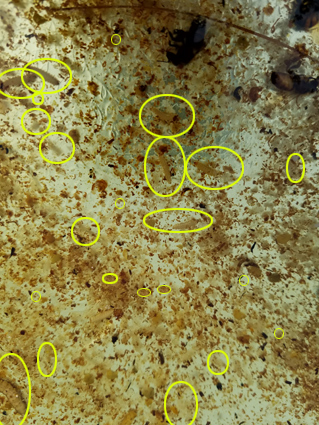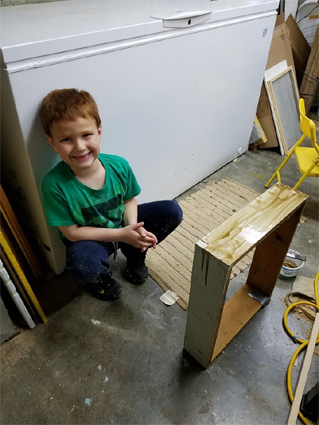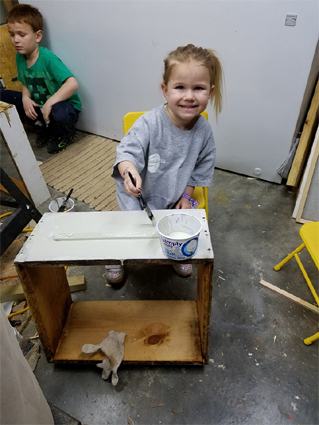Spring Supers and Catching SHB
I checked the hives this week, a week after scraping a bunch of burr comb from the hive and reversing the hive boxes.
I found that each of the 3 hives at home have 18-20 frames of bees already, one of the colonies has 10 frames of solid brood front and back. There are queen cups (still empty) everywhere and they appear like they're considering to swarm already.
I scraped all cups and burr comb and gave them each an empty super of new foundation that I've added an additional layer of wax onto to encourage them to use them right away.
The bees still have some room in their brood box right now, so they're not honey bound or out of space, but they appear itching to enlarge the colony and I want to see if they're ready to draw some frames.

Two weeks ago I added trays of oil below the screened bottom boards of the hives, hoping to catch any SHB (Small Hive Beetles) that were forced down and out by the bees, or possibly larva that were trying to drop out of the hive and into the ground below to pupate.
The technique is called "West Traps", you can google the term for more information, pictures, concept and available products from a range of suppliers.
I didn't want to spend a lot on the traps, and knowing I already had a screened bottom board, and the slots in the bottom board to hold a solid-insert/sticky board, I just went to the store and looked through the home cooking section until I found an aluminum baking sheet that would match the dimensions I needed.
I filled each pan with 1/3 bottle of vegetable oil and slid the trays under the hives with a bit of skepticism. For good measure I put screen in front and in back of the hives to keep bees out of the ear and drowning in the oil.
When I checked on the trays a week ago, I almost removed them because I had about a dozen bees who found their way into the trays and drowned.
However, when I checked them this week, the number of dead bees had not increased, but what I did find was dozens of SHB and even Wax Moth larva that had fallen through the screened bottom board and into the oil and drowned. Dozens in each tray, under each hive!
Here's a close up picture with some of the larva highlighted.

No way was I going to stop using the trays now that I saw they were working. I cleaned (dumped) the trays away from the hives and refilled them with fresh oil and slide them back under each hive.
I found that each of the 3 hives at home have 18-20 frames of bees already, one of the colonies has 10 frames of solid brood front and back. There are queen cups (still empty) everywhere and they appear like they're considering to swarm already.
I scraped all cups and burr comb and gave them each an empty super of new foundation that I've added an additional layer of wax onto to encourage them to use them right away.
The bees still have some room in their brood box right now, so they're not honey bound or out of space, but they appear itching to enlarge the colony and I want to see if they're ready to draw some frames.

Two weeks ago I added trays of oil below the screened bottom boards of the hives, hoping to catch any SHB (Small Hive Beetles) that were forced down and out by the bees, or possibly larva that were trying to drop out of the hive and into the ground below to pupate.
The technique is called "West Traps", you can google the term for more information, pictures, concept and available products from a range of suppliers.
I didn't want to spend a lot on the traps, and knowing I already had a screened bottom board, and the slots in the bottom board to hold a solid-insert/sticky board, I just went to the store and looked through the home cooking section until I found an aluminum baking sheet that would match the dimensions I needed.
I filled each pan with 1/3 bottle of vegetable oil and slid the trays under the hives with a bit of skepticism. For good measure I put screen in front and in back of the hives to keep bees out of the ear and drowning in the oil.
When I checked on the trays a week ago, I almost removed them because I had about a dozen bees who found their way into the trays and drowned.
However, when I checked them this week, the number of dead bees had not increased, but what I did find was dozens of SHB and even Wax Moth larva that had fallen through the screened bottom board and into the oil and drowned. Dozens in each tray, under each hive!
Here's a close up picture with some of the larva highlighted.

No way was I going to stop using the trays now that I saw they were working. I cleaned (dumped) the trays away from the hives and refilled them with fresh oil and slide them back under each hive.
There's no evidence of slimed frames, chewed up wax, or anything else that would suggest the wax was being compromised, so I'm guessing hives normally drop some amount of larva like this, and unless we're catching it and inspecting it, we may otherwise be oblivious to it.
In case you're wondering, I also made Sonny-Mel style traps, and had those in the top of each hive. In two weeks time, I only caught one beetle, although I've read the traps work best in the late summer or fall. The beetles I've seen are still in the colony and haven't been chased to the top/bottom of the hive yet I guess.
At any rate, I'll check the hives again in a week and see if they've made progress on the wax drawing, check the oil trays and swarming indications.
I'd like to leave as many bees in the hives as I can, for as long as I can. The more bees, the more they draw wax and collect honey. However, I'm predicting I'll be splitting each of the 3 hives soon to prevent swarming.


In case you're wondering, I also made Sonny-Mel style traps, and had those in the top of each hive. In two weeks time, I only caught one beetle, although I've read the traps work best in the late summer or fall. The beetles I've seen are still in the colony and haven't been chased to the top/bottom of the hive yet I guess.
At any rate, I'll check the hives again in a week and see if they've made progress on the wax drawing, check the oil trays and swarming indications.
I'd like to leave as many bees in the hives as I can, for as long as I can. The more bees, the more they draw wax and collect honey. However, I'm predicting I'll be splitting each of the 3 hives soon to prevent swarming.
Maeve saw some new paint brushes I bought and asked if there was anything laying around the house she could paint, so I let her and Garrison have at some bee boxes and shims that needed a new coat of paint.

Garrison chose some "metal gold" paint and Maeve chose a greenish tint of paint, that showed up white in the picture.

Comments For This Post: (4) | Post Your Comments! Hide The Comment Form